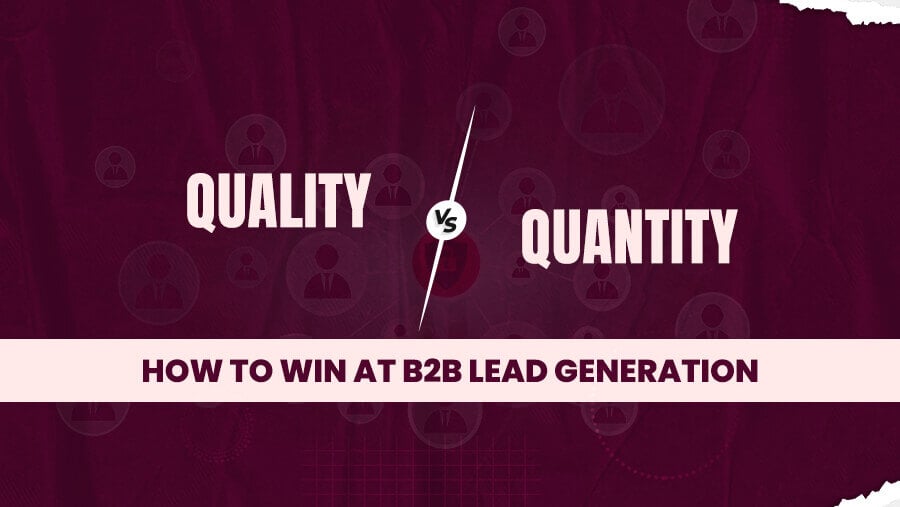
Quality vs. Quantity : How to Win at B2B Lead Generation
Imagine you're a farmer. You can plant a thousand seeds, but only a handful will grow into mature crops. The same is true in B2B marketing. You can generate thousands of leads, but if they're not the right quality, they're just a waste of time and resources.
Lead quantity vs. Lead quality, is one of the most common and crucial discussions in the world of B2B marketing, the classic dilemma.
- Should you prioritize generating a large number of leads to keep your sales funnel full?
- Or focus on fewer, high-quality leads that are more likely to convert?
The decision isn’t easy, but it can make or break your marketing and sales success.
On one hand, you want volume — after all, more leads seem to mean more opportunities. On the other, the idea of chasing down a flood of lukewarm prospects who aren't ready to buy feels like a waste of time and resources.
So, how do you find the right balance?
The reality is, both quantity and quality matter, and finding the right balance is key.
Let’s explore the risks and rewards of each approach and understand why balance is critical.
Why More Leads Isn’t Always Better
When we talk about lead quantity, we’re referring to the number of leads you generate — the total volume that enters your sales pipeline. These leads can come from various sources, like your
The goal here is to generate as many leads as possible and fill the top of the funnel, keeping your sales team busy with potential opportunities.
The challenge is, not every lead is the same.
Just because someone fills out a form on your website or clicks a link in your email doesn’t mean they’re ready to buy — or that they’re a good fit for your business. Having more leads might sound great, but if they’re not the right ones, you’ll waste a lot of time chasing dead ends instead of closing real deals.
How High-Quality Leads Can Fuel Bigger Wins
Lead quality, on the other hand, is about targeting the right people — those who not only fit your ideal customer profile (ICP) but also show genuine interest or intent in your product or service.
High-quality leads are likely to have-
- interacted with your brand multiple times
- engaged with key content
- expressed a clear need that your solution addresses
Quality leads are more likely to convert. There may be fewer of them, but they’re much more valuable because they’re already closer to making a purchase.
Debunking Misconceptions
One of the biggest misconceptions in marketing is that -

Why Focusing Only On Lead Quantity Can Backfire
High Quantity, Low Conversion
At first, the idea of getting a lot of leads sounds great, but if they’re not properly qualified, it can become a problem.
- If your focus is only on quantity, you’ll likely attract a lot of people who aren’t really interested in buying.
- You might get more website visits or form submissions, but those leads won’t easily turn into customers.
For example, imagine a company sending a broad email to thousands of people. They might get a lot of responses, but if most of those people don’t care about the product, the sales team ends up wasting time on leads that don’t go anywhere
Sales Team Overload
When the sales team is bombarded with unqualified leads, it creates overload and frustration. Your reps end up making countless calls and sending emails to people who might not even need or want your product.
This isn't just inefficient — it’s demoralizing. After all, nothing drains a salesperson’s energy faster than chasing down leads that go nowhere.
Dilution of Your Message and Brand
If you’re focused solely on lead volume, you’re probably casting a wide net, and that can lead to another problem: dilution of your message.
When you target too many prospects, it’s hard to make your marketing personalized or relevant. Instead, you end up with generic messages that fail to resonate with anyone. And in today’s market, if your message doesn’t resonate, you’re not going to stand out.
For example, sending the same email to a C-suite executive and an entry-level buyer is a recipe for disaster. One-size-fits-all marketing not only feels impersonal but can also harm your brand’s reputation.
The Risks of Focusing Only on Lead Quality
Growth Bottlenecks
On the flip side, focusing exclusively on lead quality has its downsides. High-quality leads are often fewer and can limit your pipeline’s ability to scale. If you only target highly qualified leads, you risk missing out on prospects who could convert with the right nurturing.
For instance, while a high-quality lead might have a better chance of converting if your sales team is only working with a handful of leads, you might struggle to meet your growth goals. No matter how good those leads are, having too few makes it tough to reach your revenue goals
Slower Sales Cycles
High-quality leads from bigger companies or senior decision-makers usually take longer to close because their buying process is more complicated. So, if you’re only going after these types of leads, you may end up with a slower-moving pipeline, which can impact your short-term revenue targets.
Missed Opportunities
Over-qualifying leads can also mean you’re filtering out leads that, with some nurturing, could become future customers. Not every lead is ready to buy immediately, but that doesn’t mean they should be ignored. With the right follow-up and nurturing, some “lower quality” leads can turn into valuable long-term clients.
A QUICK RECAP-

Achieving the Ideal Mix of Lead Quantity and Quality
Align Sales and Marketing
The first step in balancing lead quantity and lead quality is making sure sales and marketing are on the same page. To keep the pipeline healthy, both teams need to agree on -
- What does a qualified lead look like?
- How many leads are necessary?
To do this, it’s essential to define your Ideal Customer Profile (ICP) — the type of lead most likely to convert. You should also implement lead scoring to rank your leads based on their level of interest and fit. That way, you can strike a balance between high-volume outreach and targeted, personalized follow-up.
Implement Lead Scoring Systems
Lead scoring is a great tool for helping you balance quantity and quality. By assigning scores to leads based on their behavior (like email opens, content downloads, and website visits) and their fit (based on factors like company size, job title, and industry), you can quickly identify which leads deserve priority.
With a lead scoring system, you can ensure that your sales team focuses on the most valuable leads while still keeping a broader pool of leads in the nurturing phase.

Use Technology to Your Advantage
Automation and data analysis tools can help you manage the balance between lead quantity and lead quality.
For example, marketing automation tools can automatically segment leads based on their engagement levels, sending the most qualified ones directly to sales while keeping the others in a nurturing track.
By using tools that help you analyze lead data, you can consistently refine your strategy and make sure your sales team is working smarter, not harder.
Balancing lead quantity and quality is a challenge we all face as marketers. It’s tempting to go after high numbers, but we know that quality leads are what really drive conversions. That’s why I’ve created this checklist—so you can stay focused on what matters most: generating and nurturing the right leads, without overwhelming your sales team. Whether you’re just starting out or refining your approach, this checklist will help you stay on track and get results.
Essential Checklist for Balancing Lead Quantity and Quality in B2B Marketing
The Bottomline
In today’s B2B marketing landscape, balancing lead quantity and lead quality is crucial. Overemphasizing one at the expense of the other can lead to inefficient sales processes, missed opportunities, and slower growth. However, by aligning your sales and marketing teams, implementing lead scoring, and leveraging automation, you can achieve the right balance and drive sustainable revenue growth.
Start optimizing your lead generation for better results!

.jpg?width=60&name=deepti%20(2).jpg)


